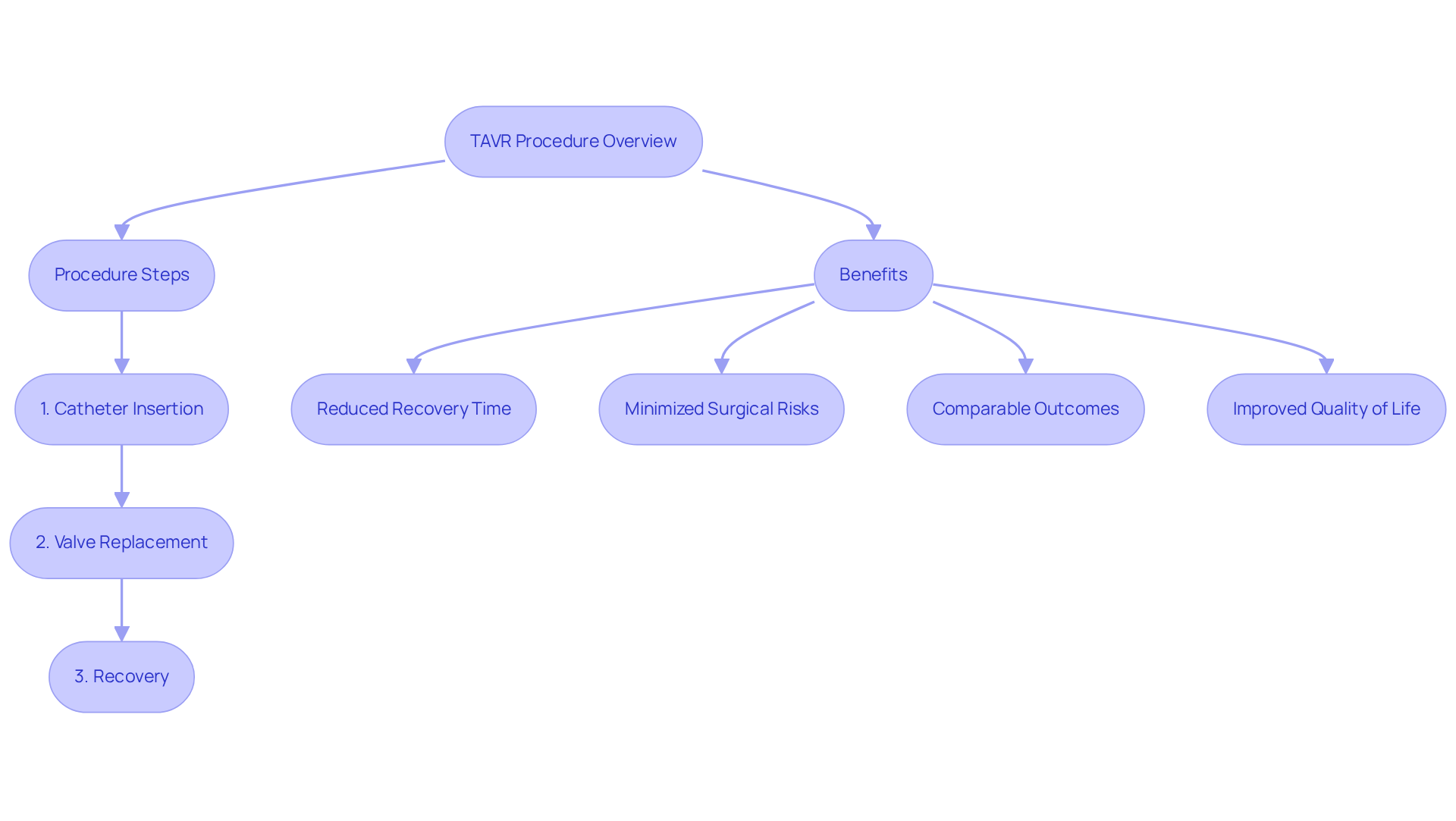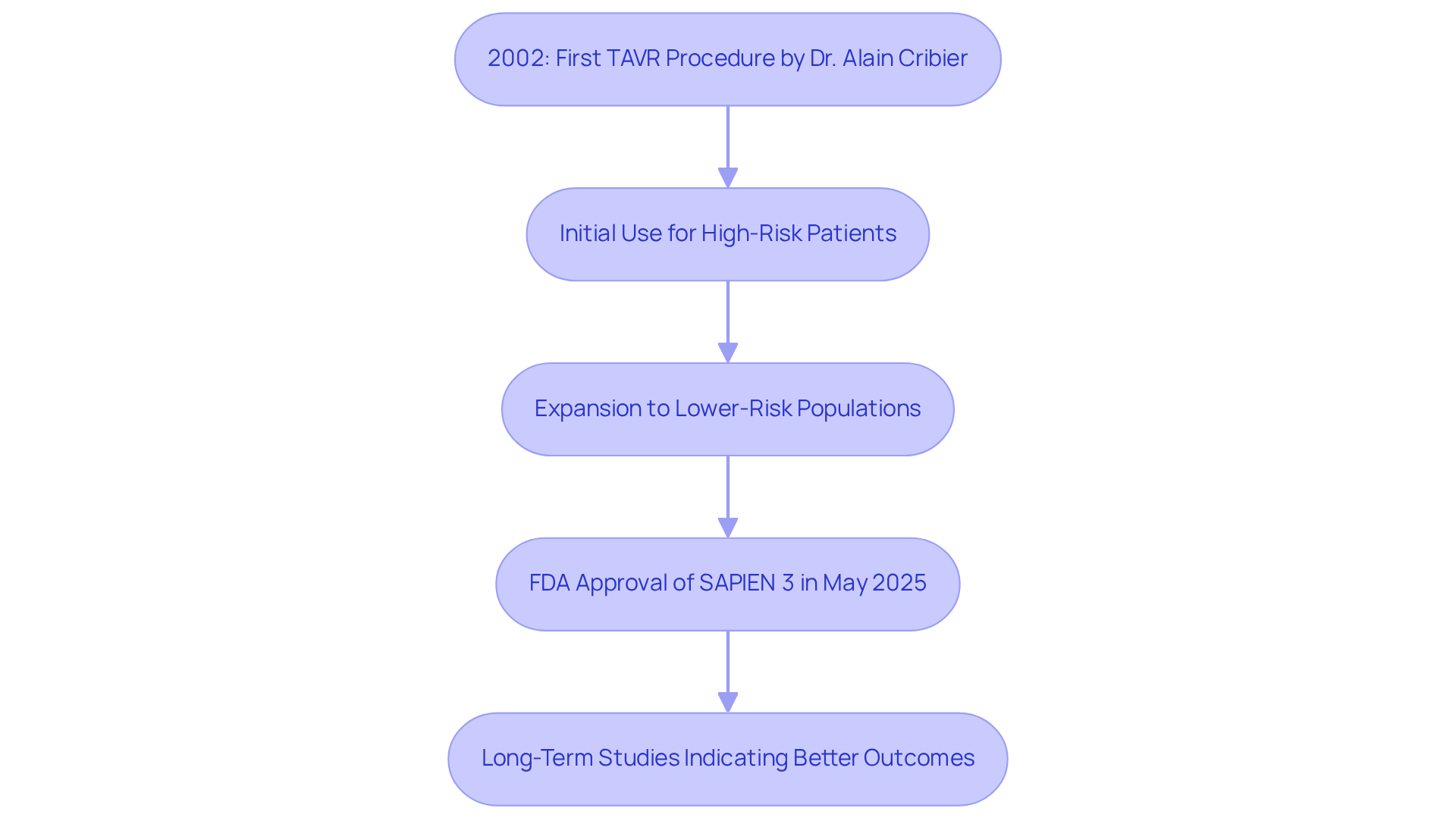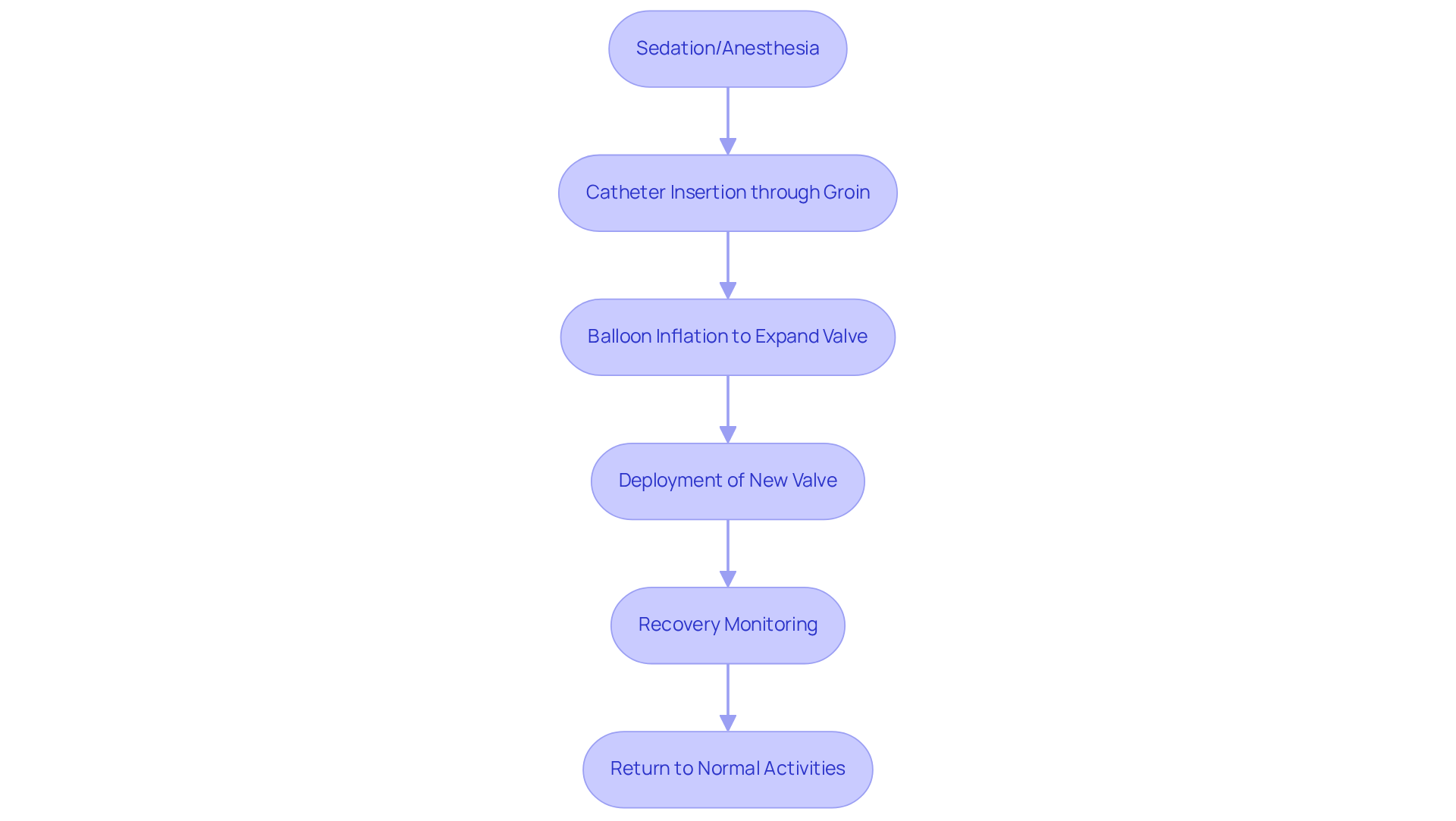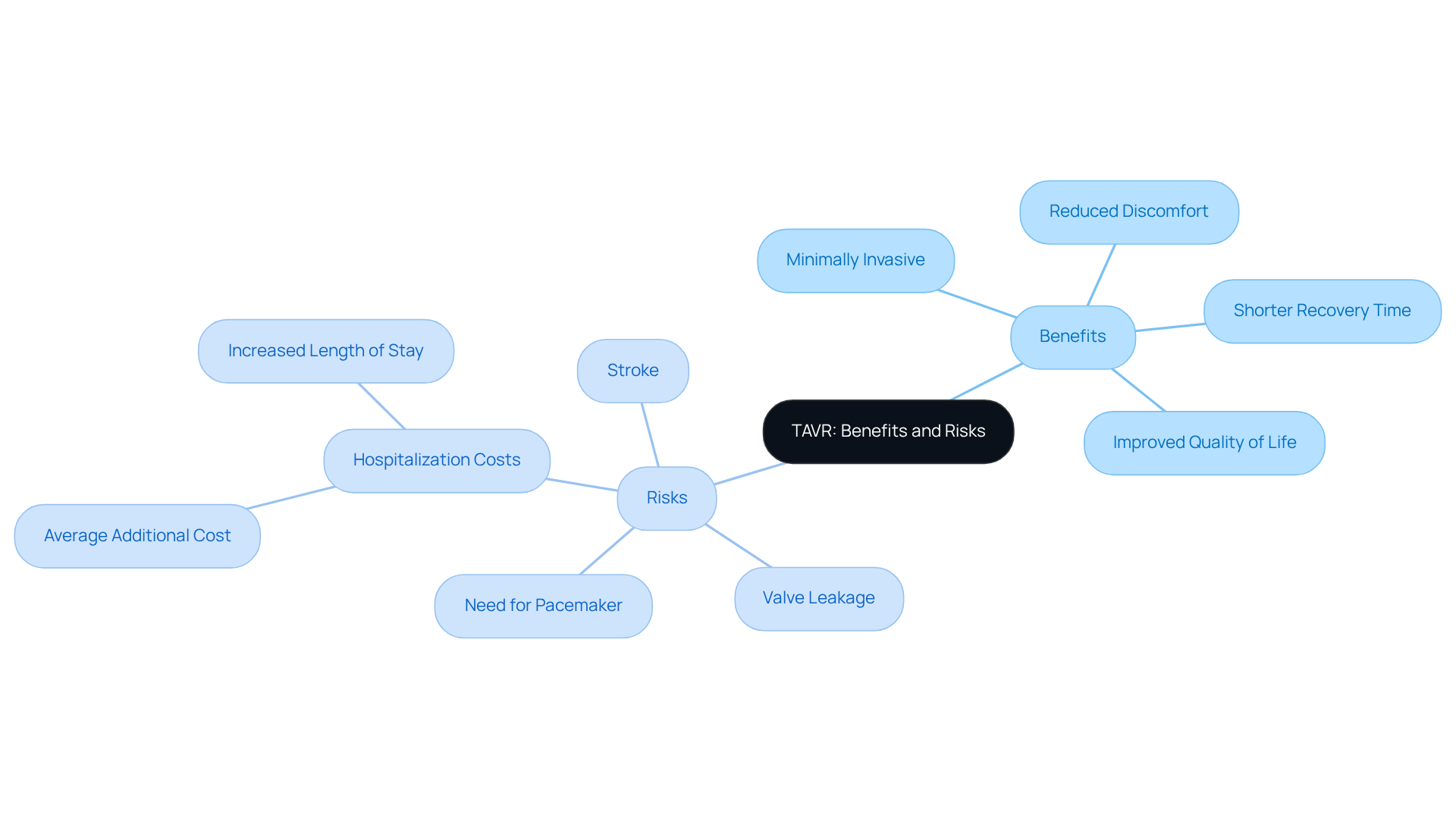


Transcatheter Aortic Valve Replacement (TAVR) is a minimally invasive procedure designed to replace a malfunctioning aortic valve. This option is particularly beneficial for older adults and those at high risk for traditional surgery. Many patients may feel anxious about their health and the prospect of surgery; however, TAVR significantly reduces recovery time and the risks associated with open-heart surgery. Furthermore, it provides clinical outcomes that are comparable to conventional methods. This means that patients with aortic stenosis can experience an improved quality of life.
If you or a loved one are facing concerns about heart health, know that TAVR is a compassionate choice that prioritizes your well-being. It’s important to explore all available options and understand how they can support your journey to better health. Remember, you are not alone in this process; there are caring professionals ready to help you every step of the way.
Transcatheter Aortic Valve Replacement (TAVR) has emerged as a groundbreaking solution for individuals facing the challenges of aortic stenosis, a condition that can significantly affect quality of life. This minimally invasive procedure not only promises a quicker recovery but also opens doors for patients who may have previously been considered too high-risk for traditional surgery.
As TAVR technology continues to advance, it’s natural to have questions about its long-term effectiveness and possible complications. What does this mean for you as you explore your treatment options? Rest assured, you are not alone in this journey, and there is support available to help you navigate your choices.
To understand what is TAVR, it is important to know that Transcatheter Aortic Valve Replacement is a revolutionary, minimally invasive technique designed to replace a constricted aortic structure that isn't functioning properly—a condition known as aortic stenosis. Unlike traditional open-heart surgery, TAVR uses a catheter, usually inserted through the femoral artery in the groin or other access points, to perform the valve replacement. This innovative approach not only reduces recovery time but also minimizes the risks associated with major surgery. This makes it particularly beneficial for older individuals and those with high-risk factors, such as diabetes and hypertension, who may not be ideal candidates for conventional surgical procedures.
At Amavita Heart and Vascular Health®, we are dedicated to combining advanced cardiac treatments with same-day convenience. Our goal is to ensure that our patients can return to the life they cherish without the disruption of hospital stays. The benefits of TAVR for older adults are substantial. Studies show that TAVR delivers performance and clinical outcomes comparable to surgical aortic valve replacement (SAVR) after four years. However, it's important to keep in mind that individuals may need another valve replacement procedure in 10 to 15 years, which is a crucial aspect for long-term planning. Additionally, the median survival for those with severe aortic stenosis is about two years, underscoring the need for effective treatment options. With this procedure, many individuals experience a —often within just a few days and with minimal limitations.
Recent advancements have also contributed to a decrease in pacemaker implantation rates among TAVR patients, dropping from 25% five years ago to less than 10% at most centers. This further enhances the appeal of the operation. A notable case study from the West Virginia University Heart and Vascular Institute showcased a successful robotic transcatheter aortic valve replacement in a 67-year-old woman, demonstrating the procedure's effectiveness. Remarkably, she was able to return home in under a week. Moreover, the likelihood of stroke for those undergoing the procedure affects only 2% to 3% of individuals, which is an important consideration.
Overall, when considering what is TAVR, it represents a significant advancement in the management of aortic valve disease, offering older individuals and those with high-risk factors a viable, less invasive option that not only extends life but also improves its quality. As Dr. Majid Mughal, a cardiologist, rightly notes, "With the method being minimally invasive, this enables our older individuals and those with more severe conditions to be eligible to undergo this treatment and enjoy an improved quality of life.

In 2002, Dr. Alain Cribier performed the first transcatheter aortic valve replacement procedure in France, which leads to the question of what is TAVR, marking a significant milestone in the management of aortic stenosis. Initially, this innovative method was available only to those considered too high-risk for traditional surgery, which may have left many feeling anxious about their options. However, as technology and techniques have evolved, what is TAVR has expanded to include lower-risk populations, offering hope and new possibilities.
Recent clinical trials have shown what is TAVR to be a procedure that is not only safe but also effective, leading to its approval for a wider range of individuals. Continuous improvements in valve design and delivery systems have greatly enhanced patient outcomes and procedural success rates. For instance, the FDA's endorsement of the SAPIEN 3 platform for asymptomatic severe aortic stenosis in May 2025 underscores the growing indications for this approach, providing reassurance to patients and families alike.
Moreover, long-term studies suggest that what is TAVR, or transcatheter aortic valve replacement, may yield better clinical results compared to conventional surgical techniques, particularly in groups that have been less studied in the past. These advancements represent a , ultimately improving the quality of care for individuals across various risk profiles. If you or a loved one are navigating these health concerns, know that there are options available, and support is here for you every step of the way.

To understand what is TAVR, the procedure begins with you receiving either sedation or general anesthesia, ensuring your comfort. A catheter is then inserted through a small incision, typically in the groin, and carefully guided to your heart. Once in place, a balloon is inflated to expand the new valve, which is deployed within the diseased valve, effectively taking over its function of regulating blood flow from your heart to the rest of your body. This minimally invasive approach significantly reduces trauma to your chest and surrounding tissues, leading to shorter hospital stays and faster recovery times compared to traditional surgical methods.
You can expect an average hospital stay of less than a week, with many patients able to return to their normal activities within just a few days after the procedure. Continuous monitoring for complications ensures your safety throughout the recovery process. Transcatheter aortic valve replacement, commonly referred to as TAVR, has a that approaches 98 percent without major complications, making it a preferred option for those with aortic stenosis. If you have high risk factors, such as diabetes, hypertension, or a family background of heart disease, this treatment can be especially beneficial for you.
Furthermore, Amavita offers comprehensive arrhythmia management services, ensuring a holistic approach to your cardiovascular care. As Dr. Philippe Genereux, M.D., emphasizes, 'There is an urgent need to change practice and transcatheter aortic valve replacement guidelines for the treatment of aortic stenosis patients, which currently recommend ‘watchful waiting’ until symptoms develop.' This highlights the importance of timely intervention.
Consider the experience of Rudolph Phillips, who received transcatheter aortic valve replacement for severe aortic stenosis. He was able to go home in under a week following the successful operation, showcasing the swift recovery linked to this groundbreaking treatment and the advantages of our minimally invasive solutions. Rest assured, we are here to support you every step of the way.

What is tavr? It is a procedure that offers a variety of benefits which can significantly improve your health. One of its most notable features is its minimally invasive nature, which greatly reduces discomfort and shortens recovery times. Many patients report marked improvements in symptoms like shortness of breath and fatigue, leading to a better overall quality of life. This procedure, known as what is tavr, can be especially beneficial for , including those with diabetes, hypertension, or a family history of heart disease.
Recent advancements in transcatheter aortic replacement technology, particularly findings from the Evolut Low Risk Clinical Trial, have shown lower rates of structural deterioration and enhanced hemodynamic performance compared to conventional surgery. However, it's important to remember that this procedure does come with some risks. Potential complications can include valve leakage, stroke, and even the need for a pacemaker. Studies indicate that approximately 31.1% of Medicare beneficiaries undergoing transcatheter aortic valve replacement may experience complications, which can lead to increased hospitalization costs and longer recovery periods.
In fact, complications have resulted in $320 million in extra expenses, representing 8.7% of overall hospital costs for Medicare individuals undergoing this procedure. Therefore, it’s essential for you to engage in thorough discussions with your healthcare provider about these risks. This dialogue will help you weigh the benefits against potential adverse outcomes, ensuring that you make well-informed decisions regarding your treatment options.
As Dr. Michael Reardon pointed out, 'The advancements in TAVR technology, which raises the question of what is TAVR, are transforming the lives of individuals with heart issues worldwide.' This emphasizes the importance of understanding both the advantages and the risks associated with this groundbreaking procedure. Dr. Martinez-Clark's expertise in minimally invasive valve treatments further enhances the comprehensive care plan tailored for each patient, ensuring that your specific needs are met effectively. Remember, you are not alone in this journey, and there are dedicated professionals ready to support you every step of the way.

Transcatheter Aortic Valve Replacement (TAVR) has emerged as a groundbreaking solution for individuals suffering from aortic stenosis, particularly those who are older or at high risk for traditional surgery. By utilizing a minimally invasive approach, TAVR not only enhances the quality of life for patients but also significantly reduces recovery times and associated risks. This innovative procedure represents a pivotal shift in the management of heart valve disease, offering a lifeline to those who may have previously felt limited by their health conditions.
The article delves into the various facets of TAVR, including its historical evolution, procedural techniques, and the substantial benefits it provides. Key insights highlight how advancements in technology have improved patient outcomes, with lower complication rates and faster recoveries. The importance of timely intervention, as well as the need for ongoing discussions with healthcare providers regarding the risks and benefits, is emphasized to ensure patients are well-informed and supported throughout their treatment journey.
Ultimately, TAVR stands as a testament to the progress in cardiac care, offering hope and improved health outcomes for many. As the landscape of heart valve treatment continues to evolve, it is crucial for patients and caregivers to explore these options and engage in proactive discussions with medical professionals. This proactive approach not only empowers individuals to make informed decisions but also reinforces the significance of timely and effective treatment in enhancing quality of life.
What is TAVR?
TAVR, or Transcatheter Aortic Valve Replacement, is a minimally invasive technique designed to replace a constricted aortic valve in patients with aortic stenosis, using a catheter typically inserted through the femoral artery.
How does TAVR differ from traditional heart surgery?
Unlike traditional open-heart surgery, TAVR is performed through a catheter, which reduces recovery time and minimizes the risks associated with major surgery.
Who are the ideal candidates for TAVR?
TAVR is particularly beneficial for older individuals and those with high-risk factors, such as diabetes and hypertension, who may not be ideal candidates for conventional surgical procedures.
What are the benefits of TAVR for older adults?
TAVR offers substantial benefits, including performance and clinical outcomes comparable to surgical aortic valve replacement (SAVR) after four years, quicker recovery times, and minimal limitations on regular activities.
How long can patients expect their TAVR valve to last?
Patients may need another valve replacement procedure in 10 to 15 years, which is an important consideration for long-term planning.
What is the median survival rate for individuals with severe aortic stenosis?
The median survival for those with severe aortic stenosis is about two years, highlighting the need for effective treatment options like TAVR.
What recent advancements have been made in TAVR procedures?
Recent advancements have led to a decrease in pacemaker implantation rates among TAVR patients, dropping from 25% to less than 10% at most centers.
Can you provide an example of a successful TAVR case?
A notable case involved a 67-year-old woman who underwent a robotic transcatheter aortic valve replacement and was able to return home in under a week.
What is the likelihood of stroke after undergoing TAVR?
The likelihood of stroke for those undergoing the TAVR procedure affects only 2% to 3% of individuals.
What overall impact does TAVR have on patients' quality of life?
TAVR represents a significant advancement in managing aortic valve disease, extending life and improving the quality of life for older individuals and those with high-risk factors.